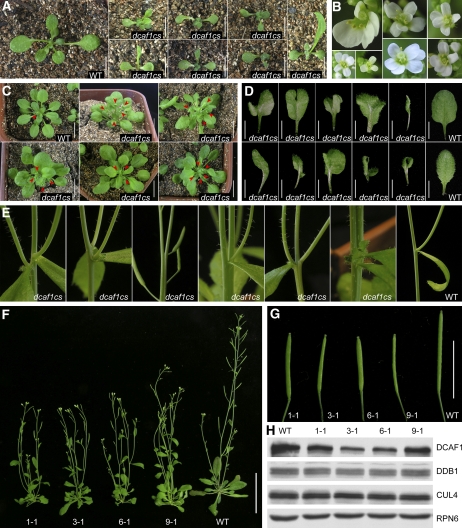Figure 9.
Multifaceted Developmental Defects of dcaf1cs Mutants.
(A) Two-week-old wild-type and dcaf1cs plants. Bars = 0.5 cm.
(B) Abnormal flowers from dcaf1cs plants.
(C) Four-week-old wild-type and dcaf1cs plants. Red arrowheads indicate the primary shoots that were starting to bolt at the transition from vegetative to reproductive growth. Bars = 1 cm.
(D) Rosette leaves from 3-week-old wild-type and dcaf1cs plants. Bars = 0.5 cm.
(E) Abnormal development of stem, node, internode, lateral shoot, axillary bud, and cauline leaves from dcaf1cs plants, with a wild-type plant as the control.
(F) Comparison of wild-type and dcaf1cs adult plants. The numbers indicate independent dcaf1cs lines. Bar = 5 cm.
(G) Comparison of wild-type and dcaf1cs siliques. The numbers indicate siliques from independent dcaf1cs lines. Bar = 1 cm.
(H) Decrease of DCAF1 protein level in dcaf1cs mutants. Total seedling protein extracts from wild-type Arabidopsis and four independent dcaf1cs transgenic lines were examined by immunoblot analysis using antibodies against DCAF1, DDB1, and CUL4. The anti-RPN6 antibody was used as a sample equal loading control. The numbers above the blot indicate protein samples from independent dcaf1cs lines.

